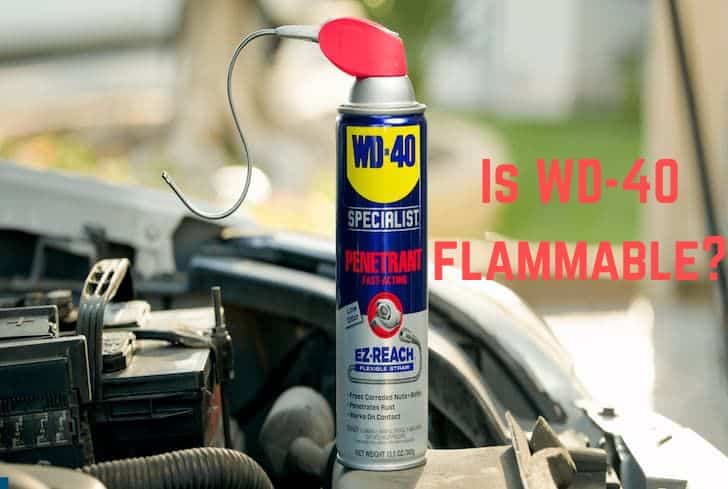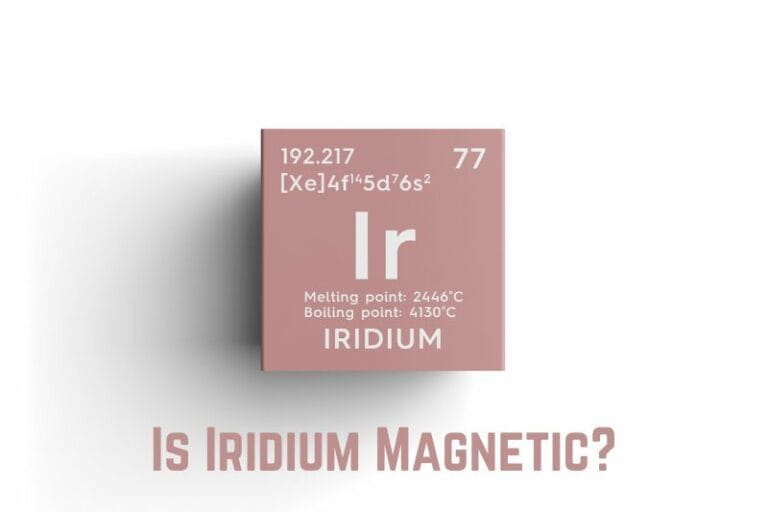Is WD-40 Flammable? (What Temperature Does it Burn?)

The WD-40 chemical is one of the most well-known ingredients in the production of items meant for cleaning, lubricating, and preventing rust. In fact, its original use is water displacement to drive moisture out of appliances and hard-to-reach spots. It is a popular product that has become an essential part of most people’s toolbox.
Since it is a multi-use product that comes in contact with a lot of surfaces, it is often wondered if WD-40 is actually flammable. We have covered everything you need to know about this chemical that is used in items concerning household items.
Read on to know more!
Is WD-40 Flammable?
WD-40 does not catch fire very easily, but when lit, it can produce a small amount of smoke and burn for a while. It will burn at a low-temperature flame without inflicting any harm, but the WD-40 will be consumed. If you want consistent prevention against rust, then you will have to reapply layers.
WD-40 is combustible as a spray, even if it may be made of components that can easily evaporate at room temperature and are not flammable. However, if the WD-40 product you are using is powered by butane or similar flammable aerosol, it is incredibly flammable in gaseous form.
This is because of the shift in surface-to-volume and there is a good possibility that you will ignite a fire if you spray WD-40 near an open flame or flare. Hence, it is essential to use WD-40 in a place that is well-ventilated and clear of flames, sparks, and other fire-starting materials.
What is WD-40?
The WD-40 is a type of oil and a product of a company of the same name. Since the formula for the oil was developed by Rocket Chemical Company before the separate brand, the product has become a trademark for the WD-40 brand. It is mainly used to prevent rust and displace moisture from machinery.
The majority of the water-displacing sprayers sold under the WD-40 brand are made in San Diego, California, by the company. Some ways in which you can use this oil are to lubricate machines, as prevention for rust and conformal coating, and for removing moisture.
The ‘WD’ in its name stands for ‘water displacement, as per its many beneficial properties. For example, WD-40 can be used for stopping door squeaks, eliminating moisture, stopping corrosion, and unsticking objects. It has become a very well-known and popular product across the world.
Is WD-40 Flammable After Drying?
The main constituent of WD-40 is petrochemical distillates, so it is no doubt that the oil is flammable. However, when dry, it burns slowly without any sound, so it can be called more combustible than flammable. When heated, it goes under oxidation, releasing heat energy and making the oil more likely to combust.
Still, WD-40 is flammable after drying – meaning that if you spill some on your clothes and it dries up, it will most likely catch fire. Since it contains petroleum distillates, the residue from the oil, which is very hard to wash off, is very combustible and can catch flame easily.
How Long is WD-40 Flammable?
WD-40 is an oil with many different chemical compounds, out of which only about 20% is the acting lubricant. Hence, if you try to burn it, it is likely that it will stay on fire for about 15 minutes until it completely evaporates, though never completely.
If you were to leave an open bottle of WD-40 out in the open, most of the liquid will dry up and leave behind an oily, greasy substance, mainly the aerosol and petroleum components.
These components are responsible for the flammability of WD-40. They will make it burn slowly for up to 15 minutes until it evaporates.
At What Temperature Does WD-40 Burn?
According to the official Material Safety Data Sheet (MSDS), the flash point of WD-40 is around 47°C or 117°F in its liquid phase. It has an explosion sensitivity to static electricity, but none to impact. However, you should be careful as it contains gas under pressure that explodes when heated.
Although the company made its product less flammable than it previously was, the flashpoint of the WD-40 is still quite low. Any source of flame can ignite it, especially when it is in gaseous form.
When WD-40 is burnt, it does not only produce gasses like CO2, water, and its petroleum components. It also gives out toxic hydrocarbons and causes a reaction with nitrogen. Hence, although consumers have not been warned about this, WD-40 fumes should not be inhaled.

What Should You Not Use WD-40 On?
Despite its many beneficial properties, WD-40 can be toxic, especially when consumed in any way. It can specifically be harmful when inhaled, brought close to a flame, and cause irritation with what it comes in contact with. In fact, California has illegalized the product due to it containing too many volatile organic chemicals.
Hence, there are a few purposes, for which WD-40 should not be used at all.
1. To Put On Door Hinges
Squeaking door hinges can be a very annoying problem, and it is certain that WD-40 will stop it. However, it will also cause the hinges to get covered with dust and debris which will over time make your hinges darken and turn black. It is more advisable to use vegetable oil or other rust removal methods on your hinges.
2. To Fix Bike Chains
WD-40 can help lubricate bike chains and make them smoother to operate, but it can again cause dust to stick if you apply it to the strings.
With its ability to dissolve solvents, WD-40 will remove any existing lubricant, leaving your chain and drivetrain drier than before. As a result, applying WD-40 to lubricate a chain is worse than applying no lubrication at all. Always use cleaning and lubricant made for bike drivetrains.
3. To Fuel Paintball Machines
WD-40 should never be used for paintball guns because it has many toxic properties. It can seriously damage the rubber hoses inside, so only air tools should be used to clean your gun. Besides, paintball guns and machines are for children, from which flammable and toxic objects should be kept far away.
4. To Fix Locks
Using WD-40 on locks, padlocks, security systems and mechanisms may cause the object to wear them out before time. You are better off using graphite for this problem.
The fundamental cause of this is that WD-40 is water and oil displacing solvent rather than a real lubricant. This implies that it truly has the ability to eliminate whatever lubricant was previously present in the lock, leaving it dry and prone to sticking.
5. To Fix Gadgets
If the metal parts on your gadgets, like the buttons or the keypad stop working, then WD-40 will not be able to make it any smoother or fix it completely. In fact, WD-40 can damage the plastic and even destroy the circuits and the mechanisms of the gadget if it gets inside the device.
6. For Substance Abuse
Lastly, WD-40 should never be used as a mind-altering drug as it can prove to be extremely toxic for your body. Over time, it can do serious damage and even cause fatal diseases.
Does WD-40 Evaporate?
WD-40 is a petroleum-based solvent and is mixed with many chemicals apart from the lubricant components that make it the product it is. Hence, it can evaporate, but not completely. Only 20% of the components of WD-40 will not evaporate while the rest does, upon burning or leaving exposed to air.
Whether your WD-40 product will evaporate or not depends highly on the environment and the temperature you leave it in. For instance, if you leave out on a hot day with direct sunlight, it will evaporate in 15 minutes or less.
So, to make sure it will not evaporate and complete its shelf-life of 5 years, you need to keep it in an airtight container.
Also, when you apply the product to a surface, the oil will dry up and evaporate in around 15 minutes and leave behind a nice, lubricated finish.
Is WD-40 Toxic?
Although WD-40 is used for various purposes around the house, it can be highly toxic in many ways. Apart from its flammable properties, if it is inhaled, WD-40 can cause nasal and respiratory irritations, which is typical of many aerosols. Additionally, it can also result in headaches, nausea, and vertigo for some people.
Another odd but common use of WD-40 is its abuse for its high-inducing properties. Since it consists of aerosol, upon breathing, it can cause the inhaler to get high which can then lead to potential abuse. However, you must remember that doing so can lead to serious damage to the body and sometimes even death.
Lastly, if it comes in contact with your skin, it might cause irritation, though it will just be a slight burning and not cause any infection.
Frequently Asked Questions
Is Non-Aerosol WD-40 Still Flammable?
If the Non-Aerosol WD-40 is in liquid or vapor form, it is still flammable as fire is made when either of the two is mixed with air and the explosive components of the oil.
Does WD-40 Smoke When Hot?
If you heat up WD-40, it does start smoking up and causing toxic fumes which might be dangerous to inhale. However, this is not an issue as long as the vapor is allowed to escape out from a crack or vent.
Is WD-40 Toxic To Breathe?
WD-40 when burnt can create a toxic fume that can cause irritation in the respiratory and nasal system at the minimum, and at its most, can cause serious lung damage. Additionally, users might also experience dizziness, headaches, or nausea, so it is important to have ventilation if you are burning WD-40.
Is WD-40 A Lubricant or a Cleanser?
The WD-40 is a multi-purpose product and acts as a cleanser, lubricant, and coating for machinery. Since it has anti-corrosion agents, it can be used for the removal of moisture and soil from objects.
Final Thoughts
Although the WD-40 is known to be non-hazardous, one should be careful when handling objects that can burn at higher temperatures. We hope that this article has helped you understand this useful but flammable chemical that you should be careful with around fire.




![Is Chapstick Flammable? [Lip Balm, Lipstick, Lip Gloss]](https://eartheclipse.com/wp-content/uploads/2023/03/is-chapstick-flammable.jpg)
